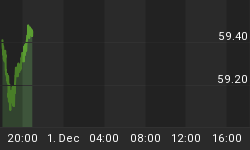Industrial commodity prices have surged in the past few years with everything from crude oil to copper registering record high prices. The Fed has expressed concern that rising and high commodity prices could push up the rate of consumer price increases. But is there any historical evidence to support the Fed's concerns? Not much, as shown below.
Charts 1 and 2 show the relationship between year-over-year percent changes in the all-items CPI and the core CPI vs. year-over-year percent changes in the Journal of Commerce (JOC) industrial commodity price index. The highest positive correlations occur when the JOC is advanced by 11 months with regard to the all-items CPI (correlation coefficient of 0.50) and advanced by 13 months with regard to the core CPI (correlation coefficient of 0.41). The magnitudes of these correlations suggest that there is some relationship between industrial commodity price inflation and consumer price inflation. But let's employ some heavier statistical analysis before rushing to conclusions.
Chart 1
Chart 2
Let's run some ordinary least squares regressions to assess the magnitude of the pass-through of industrial commodity price inflation to consumer price inflation. The regression results relating to the all-items CPI are shown in Table 1. The AR(1) and AR(2) "variables" are autocorrelation (trend) correction variables. Rounded, the coefficient on the year-over-year percent change in the JOC price index (lagged 11 months) is 0.016. This means that in the past, a 10% year-over-year increase in the JOC has 11 months later added about 16 basis points to the year-over-year percent change in the all-items CPI. So, yes, there is some historical evidence of a muted pass-through of industrial price inflation into all-items CPI inflation.
Table 1
What about the pass-through into core CPI inflation? The regression results for this are shown in Table 2. Rounded, the coefficient on the year-over-year percent change in the JOC price index (lagged 13 months) is 0.004. This means that in the past, a 10% year-over-year increase in the JOC has 13 months later added about 4 basis points to the year-over-year percent change in the core CPI. But even this paltry contribution to core inflation may be little ado about nothing inasmuch as the t-statistic on the JOC inflation variable is statistically insignificant. This means that the coefficient is not statistically-speaking different from zero, implying no relationship to core inflation.
Table 2
These are the facts, ma'am. But why hasn't industrial commodity price inflation had more impact on consumer price inflation? Perhaps the BLS is not measuring consumer price inflation correctly. Or perhaps raw materials represent a relatively small proportion of the production costs of goods and services in the U.S. For all the excitement about $74 per barrel crude oil and $3 per pound copper, the JOC price index is up less than 8% vs. year-ago (see Chart 3). And a year ago, which, given the lags, would be the time when the behavior of industrial commodity prices would be relevant to consumer price inflation now, the JOC was declining on a year-over-year basis. So, unless "it's different this time," the Fed need not fret too much about the inflationary impact of current or recent past industrial commodity prices. Other research that I have done suggests that there is about a three-year lag between money supply growth and inflation. If the Fed is serious about controlling the rate of price increases - price increases of goods/services and price increases of assets - it ought to strive for low and steady monetary growth and fret less about the behavior of industrial commodity prices.
Chart 3















